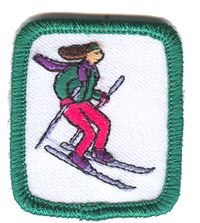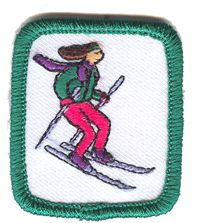SKI (IP)-ORIGINAL
SKI (IP)-ORIGINAL
Couldn't load pickup availability
Winter Skiing Interest Patch (approved in 2000)
This Interest Patch can be earned in connection with EITHER downhill skiing OR cross country skiing. References to “skiing” or “ski equipment” below should be read to apply to the type of winter skiing you have chosen to pursue in connection with this earning this Interest Patch.
Skill Builders
(Complete one requirement from each catergory. You must complete the starred element .)
*1. Ski Trip: Go on a ski trip in which you are on skis, practicing the sport for at least 4 hours.
2. Exercise Program: Under the guidance of an instructor or based on research you conduct concerning appropriate physical preparation for skiing, develop a cardiovascular exercise program specifically designed to increase your endurance in preparation for the ski season. Follow the exercise and cardiovascular fitness plan for the two months prior to ski season.
- First Aid: Learn appropriate first aid treatment for the following skiing related injuries: snowblindness, sunburn, frostbite, bruises and sprains, and hypothermia. Explain how these injuries might be avoided. Learn what you should do if your skiing companion is injured while skiing (how to report a skiing accident and how to summon help to the location of the injured skier).
- Ski Etiquette and Rules of the Road: Learn and tell the meaning of the standard signs that indicate ski trail and slope difficulty and that help you to locate and follow skiing trails and slopes. Discuss the rules of ski safety and etiquette on the trails or slopes and in lift lines.
Technology
- Weather: Check the weather forecast before you go skiing. Be able to explain the importance of a rising or falling barometer, a warm or cold front, and the windchill factor. Learn to interpret the cloud and wind signs in your area that indicate changing weather conditions. Learn how snow and ice conditions change in different weather conditions.
- Equipment: Learn the names and purposes of the pieces of equipment used in your sport. Learn how to insert and release a ski boot from a ski binding. Understand the importance of wearing ski boots that fit properly. Explain the function of ski brakes and powder straps. Learn about the choices of ski shapes and sizes and the pros and cons of each. Learn about the different materials used in the manufacture of skis and the differences in performance. Learn how to choose poles that are appropriate for you.
- Equipment Maintenance: Learn about adjusting the settings on ski bindings and the importance of having this done correctly. Learn about maintaining ski equipment between uses and preparing equipment for use.
- Clothing: Learn how to dress for skiing. Be able to explain the advantages of dressing in layers. Compare the different fabrics and types of insulations used to manufacture ski clothing and the pros and cons of each. Be able to explain what clothing your would select to conserve body heat, to allow perspiration to escape, and to keep out wind and water. Learn about the types of eye protection worn for skiing.
- Ski Lifts: Learn about the principles of physics which are applicable to the operation of ski lifts and to the manufacture of artificial snow. Explain these principles to someone else.
- Science of Skiing: Investigate the scientific principles which relate to a skier’s performance. Explore concepts of aerodynamics, physics, wind resistance as they relate to skiing. Be able to explain which “simple machines” are used as ski equipment.
Service Projects
- Collect cold weather clothing (hats, boots, mittens) and donate these to an organization which fills a need in the community.
- Develop a list of information about ski resorts and other locations which are appropriate for participation in your sport; provide this information to Girl Scout troops in your Council and to the High Adventure specialist for possible inclusion on the high adventure vendor list.
- Organize a ski equipment and clothing swap for families in your area, so that they can participate in the sport in a more economical manner.
- Maintain an existing bird-feeding station through the winter months. Keep a record of the species and numbers of birds that use it. Record how their behavior changes when the weather changes. Observe bird life while participating in a winter sport and compare your findings with those from the feeding station.
- Fill a need in the community that presents itself during the winter (ski season) months. For example, while your group is preparing for your ski trip, collect school supplies, canned goods, or other essential items that are in short supply and provide them to a needy segment of your community.
- Teach a younger group of girl scouts about skiing. Prepare a photo essay or video about your skiing experience. Tell the younger girls about the expanded and high adventure opportunities available to older girl scouts.
Career Exploration
- Interview two persons whose jobs relate to skiing and find out how they became involved. Examples include a ski patrol member, a ski instructor, a ski equipment salesperson, or an operator of a ski area. Also find out about their training and/or educational background, and the advantages and disadvantages of their career choice.
- Do internet or library research into the biographies of former members of the U.S. Olympic (or other competition) ski team. Find out what they did after they retired from competitive skiing; try to determine what effect competitive skiing had on their later careers.
- Learn how competition skiers are scored based on their performance. Watch a ski competition on television or video and score the competitors. Analyze the qualities of the top skiers. scoring


